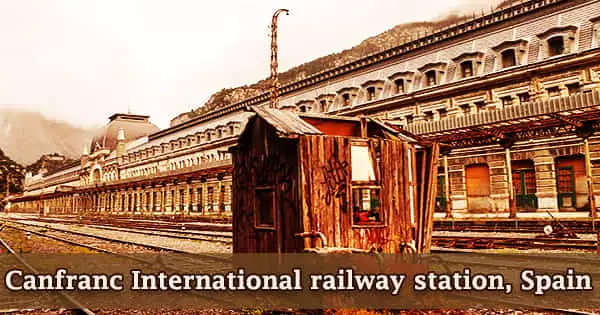Canfranc International railway station (Spanish: Estación Internacional de Canfranc) was one of Europe’s major rail terminals when it was opened in 1928 and played a crucial role throughout WWII. It is a former international railway station in the Spanish Pyrenees town of Canfranc. At one end of the station lies the Somport railway tunnel, which brought the Pau-Canfranc railway into France over the Pyrenees. The majestic ancient station in the Pyrenees took 75 years to build, with 365 windows and a large 200-meter-long platform, opening in 1928 just in time for the financial crisis before being damaged by a fire a few years later.
The station saw several highs and lows, with services being briefly halted due to the purposeful closure of the Somport tunnel during the Spanish Civil War, while being heavily used by foreign traffic as the “Casablanca of the Pyrenees” during WWII. Since its conception in 1853, the station, a once-glamorous behemoth of a facility on the Spanish-French border, has experienced every possible adversity. The edifice that was once known as the “Titanic of the Mountains” fell into terrible ruin due to war, fire, and mismanagement.
Canfranc station has been abandoned since 1970, but efforts to restore a train route through the region might bring it back to life shortly. The local administration wants to restore the international line and renovate the station, which would entail converting the old station building into a hotel and replacing it with a new one. The European Union made money available in February 2020 for both the resumption of international services and the station’s restoration.

The magnificent edifice, which struggled through the Spanish Civil War, WWII, and Spain’s Franco regime, ultimately shuttered its doors in 1970, becoming a crumbling monument to the area’s unfulfilled dreams. Rail operations at Canfranc International Railway Station has been a distant memory for over 50 years. The idea for the building as a crossing point in the Spanish Pyrenees near the French border was conceived in the mid-nineteenth century, but the sumptuous edifice was not completed until 1928.
The Spanish hotel company Barceló has commissioned a €27 million restoration of the Wes Anderson-esque edifice, thanks to a €12 million investment from the government of Aragón for the train tracks and development of the surrounding region. Because it served as a vital crossing point for commodities and was the focus of espionage for Nazi and Spanish authorities during WWII, the station and its surrounding region earned the nickname “Casablanca in the Pyrenees.”
Despite the fact that it has been inactive for so long, it is obvious that Canfranc’s position as a historical landmark has triumphed over its function as a functional train terminal. Following the war’s end, train traffic quickly recovered to pre-war levels. The relative stability of the 1950s and 1960s ushered in an era of prosperity, but it was short-lived. The station’s and the Pau-Canfranc railway’s futures became progressively threatened in the 1960s, and both were chronically underfunded, resulting in numerous accidents that finally prompted safety concerns.
After a railway crash into a neighboring bridge, the station limped on until 1970, when it eventually closed. Canfranc’s destiny was sealed when it was deemed that rebuilding the bridge would be too costly. The L’Estanguet bridge on the French side of the Pyrénées Mountains was destroyed by a train derailment on the Pau-Canfranc railway line. The French government chose not to repair the bridge due to financial pressure from the French national railway operator SNCF, thereby forcing the cross-border route to close.
Now, a new initiative combining the Government of Aragon, the French government, and the European Commission is attempting to restore the station to its former grandeur. During the 2010s, the railway station was open for the twice-daily passenger trains to and from Zaragoza-Delicias railway station, as well as the occasional freight train to the grain silo, despite its relatively limited amenities. The station was designated as a Site of Cultural Interest in 2007. The Canfranc line is anticipated to be completely operational by 2026, after work to restore the Somport tunnel, which connects Spain and France, which is expected to be finished by the end of 2022.
The station’s architecture was purposefully built with obvious symbolism: the façade has an eclectic Beaux-Arts style apparently influenced by French palace architecture, while the inside contains elements derived from classical Roman architecture. Ourists began wandering about the decrepit station, enthralled by a relic of the industrial past. A small rail service was also restored; rumors of a resurrection circulated in 2017, and it is currently the subject of a substantial financial investment and reconstruction.
A huge locomotive depot, two sheds for freight transshipment between French and Spanish trains, several additional structures, and a vast track layout arise from the location. The Somport tunnel, which connects Spain and France, will reopen in 2026, with the goal of having a fully operating Canfranc line and station. A school was built in the town for the children of the station’s French personnel since a portion of the station was deemed French territory.
















